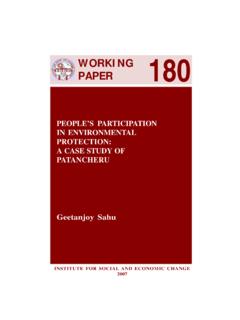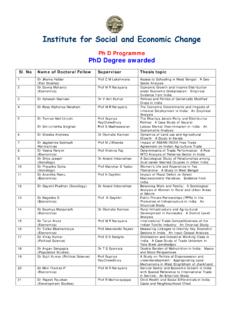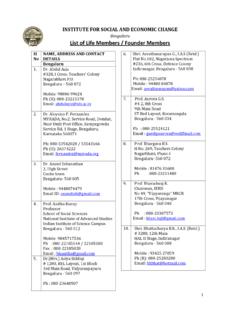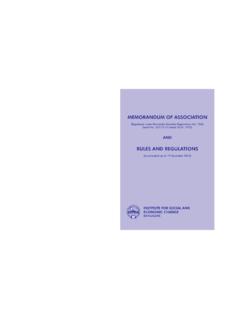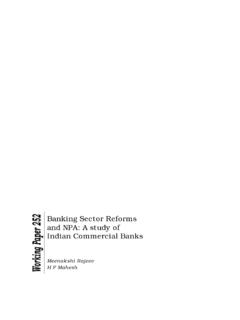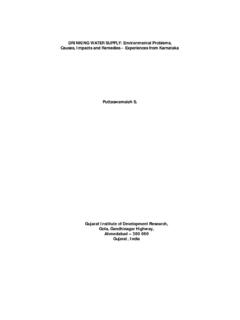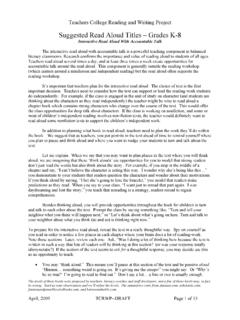Transcription of PUBLIC FINANCE - Institute for Social and Economic …
1 INTRODUCTION TO PUBLIC FINANCE BY CARL C. PLEHN, PROFESSOR IS THE t1 NIYERSITY OF CALIFORNIA "Je n'impose rieni je nc propose me-me rien,. j'expose" DUNOYER SECOND EDITH?N. REYISED AND ENLARGED NtIn lliarlt THE MACMILLAN COMPANY LONDON: MACMILLAN Jr: CO., LTD. 1902 .AU Muflia r68M'ved COPYRIGHT, 18(16, By TIlE MACMILLAN COMPAXY. Set up and electrotyped August, 18g6. Reprinted August. lSw. Second edition, re, May, I<}OO ; July, 1902. Notill'oob tllnss I. S. Culhing t. Co. -Benriek k Smith Norwood M&II. PREFACE THIS Introduction to PUBLIC FINANCE is intended to be an elementary text- book . It contains a simple outline of those ~hings which are necessary to prepare the stu-dent for independent research; a brief discussion of the leading principles that are generally accepted; a state-ment of unsettled principles with the grounds for con-troversy; and sufficient references to easily accessible works and sources to enable the student to form some opinioJ:!. for himself.)
2 The references that are given are not so much for the purpose of sustaining the author's statements, which any advanced student or teacher can easily trace to their sources, as to enable the beginner to add to his information on points that. are of necessity briefly treated here. Both the American and the English systems of taxa-tion are badly in need of reform. PUBLIC opinion is gradually awakening to this need. Financial questions are widely discussed. There can be no doubt that the most pressing reforms of the close of the nineteenth century are tax reforms. The rapid extension of govern-mental functions -the invasion by the government of fields of activity that lie near to the welfare of the people -has given rise to great interest in the financial side of v vi PREFACE these activities. It is hoped ihat this work may be help-ful in the accomplishment of these needed reforms. The Introduction to PUBLIC FINANCE can be intelli gently studied by any person already familiar with the general pl'inciples of Political Economy.
3 Technical details and wearisome tables of statistics have peen avoided wherever possible. Abundant references to } compilations are, hoy-rever, given, so that such matters can be readily looked up if wauted. The coun tries whose financial systems have been chiefly used to illustrate principles are England, Germany, France, and the United States; other countries have been drawn upon only for particularly pertinent examples. A brief but complete history of tbe financial practices of the four countries named has been given. The countries most extensively studied are England and the United States. Although the book has been written from the point of view of an American, the author ventures the hope that it may not prove the less useful to English students. CARL C. PLEHN. BERKELEY) CAL.) August, 1896. TABLE OF CONTENTS INTRODUCTION SECTION 1. Definition, scientific character, and relations of PUBLIC FINANCE . SEC. 2. History of the science. SEC. 3. Method and subdivisions of the subject.
4 SEC. 4. Desirability and feasibility of a single method of classification throughout the whole sub-ject. Page 1 PART I PUBLIC EXPENDITURE CHAPTER I THE NATURE OF THE STATE j ITS FUNCTIONS AND THEIR SECTION 1. Po1itical science sets no definite limits to the ~xtcnsion of Stare functions. SEC. 2. PUBLIC FINANCE finds a limit in the revenue-yielding strength of the State. SEC. 3. PUBLIC expendi-ture in early times. SEC. 4. PUBLIC expenditure in Greece and Rome. SEC. 6. Feudal expenditure and the beginnings of mod. ern. SEC. 6, Classification of expenditure. Page 17 CHAPTER II EXPENDITURE EXCLUSIVELY FOR THE COMMON BENEFIT SECTION 1. Expenditure for general administration. SEC. 2. Ex-penditure for the legislative department. SEC. 3. Expendi-ture for PUBLIC buildings. SEC. 4. Expenditure for defence. SEC. 5. Expenditure for means of transportation. SEC. 6. Ex-penditure for education. SEC. 7. Assistance of private industry and commerce. Page 33 vii viii CONTENTS CHAPTER III EXPENDITURE FOR THE BEXEFIT OF IN"DIVID"['AU!]
5 SECTION 1. Expenditure for charities. SEC. 2. Pensions. SEC. 3. Bounties and ;, protection." SEC. 4. Expenditure tor the ad ministration of justice. SEC. 6. " Betterment II of property. SEC. 6. E~penditure in PUBLIC industries. Page 53 PART II PUBLIC REVENUES CHAPTER I THE CHARACTER AND CLASSIFICATIO:s' OF PUBLIC REVENUES SECTIOV 1. Early forms of rc,, cnuc. SEC. 2. The growth of con stitutionalism results in uniformity of the revenue systellJs of the different countries. SEC. 3. Different States find the same justification of taxation. SF-c. 4. Compulsion is universal. SF-c. 6. Classification of revenues, definitions of fees, taxes, and prices. S cs. 6 and 7. Further considerations on classifi-cation. Page 69 CHAPTER II I THE CLASSIFICATION OF FEES; DEFPUTIONS SECTlO"N 1. The measure of taxation distinguished from the justi-fication; benefit theory and faculty theory. SEC. 2. Difficulties in the classification of taxes. SEC. 3. Direct and indirect :es. SEC.
6 4. Taxes on persons, property, income. SRe. 5. Other classifications of taxes. SEC. 6. Classification of fees. SEC. 7. Economic revenues. SEC. 8. Definitions of various terms used. Page 83 CHAPTER III THE TAX. SYSTEM SECTro~ 1. All nations use many different taxes; no single tax feasible. SEC. 2. What, in the opinion of nations, constitutes CONTENTS ix tbe ideal of correct or just The benefit theory; the legal theory in the United States. SEC. 3, The faculty theory; what constitutes faculty. SEC. 4. Other theories and progres-sion. Page 105 CHAPTER IV TUE DEVELOPMENT OF TAXATIO:S-BEFORE TUE llrnUSTRIAL REVOLUTION SECTION 1. Feudal dues commuted, and voluntary contributions be-come taxes. SEG. 2. IIif,tory of taxation in :France. SEC. 8. History of Crown tl\Xation in England. SEC. 4. History of local taxation in England. SEC. 5. Colonial taxation in America. Page 123 CHAPTER V TnE DEVELOPllENT OF TAX SYSTEllS SIxeE TUE L"iDUSTRlAL REVOLUTION SECTIOX 1. The effect of the industrial and political revolution.
7 SEC. 2. General outline. SEC. 3. Development of in Prussia. SEC. 4.' In France. SEC. 5. In England. SEC. 6. In America. Page 144 CHAPTER VI EXCISES SECTION 1. Comparison of excises and customs; and direct co?t-sumption taxes. SEC. 2. Purposes and principles of the ex-cises. SEC. 3. )-fethod of assessment. SEC. 4. Typical excises. S c. o. Proper field for excises. Page 169 CHAPTER VII CCSTO)IS DUTIES SECTIONS 1 and 2. Customs duties defined. SEes. 3 and 4. The pur-poses of customs duties, both fiscal and political. Protective and revenue tariffs. SEC. 5. The protective principle widely applied. SEC. 6. Tbe tax cbaracter of protective duties. SEC. 7. CUBtoms duties as a source of revenue. SEC. 8. History of cus-toms duties in England. SE; The German customs union and the Imperial tariffs. SEC. 10. History of the French tariff. ::;JJ:C. 11. Tariff history of the United States. Page 182 or CONTENTS CHAPTER VIII PROPERTY TAXES PART 1. The General Property Tax SECJtON 1.
8 Theory of general property tax and the objections to it ba.'led upon the experience of the United States. SEC. 2. Sci-entific judgment of the general property tax. Page 208 PART 2. Special Property Taxes SEC. a. 'fhe land tax. SEC. 4. Ruilding tax. SEC. 5. Taxation of capital. SEC. 6. Inheritance tax. Page 219 CHAPTER IX PERSONAL TAXES SEcrION 1. Poll tax. SEC. 2. Theory of the income tax. SEC. 3. Piace of the income tax in the tax system. SEC. 4. Prussia income tax. SEC. 5. The British property and income tax. Income taxes in the United States. Page 231 CHAPTER X THE INclDExCE OF TAXATION S1 CTION 1. Incidence depends upon the system; of shift-ing and incidence. SEC. 2. Shifting mayor may not defeat the purpose of the tax. SEC. 3. Shifting adds to the burden of taxation. SEC. 4. Shifting cannot take place when taxes are universal and equal. SEC. o. Incidence of excises and CllS-toma. SEC. 6. Incidence of the general property tax. SEC. 7. Inc!dence of special property taxes and of personal taxes.
9 Page 248 CHAPTER IX FEES AND INDUSTRIAL EARNINGS SE~TIOS 1. Connection between fees and industrial earnings; development of fees into taxes. SEC. 2. Judicial and legal fees. SEC. 3. Administrative fees. SEC. 4. Special assess-ments. SEC. 5. Postal fees. SEC. 6. Revenues from PUBLIC property. SEC. 7. Revenue from PUBLIC industries. Page 259 CONTENTS xi PART TTl PUBLIC INDEBTEDNESS CHAPTER I THE GROWTH AND NATURE OF PUBLIC CREDIT SECTION 1. Size of PUBLIC debtR. SEOS. 2 and 3. The nature of SEC. 4. Wherein PUBLIC credit differs from private. SEC. 5. Economic effects of PUBLIC borrowing. SEC. 6. Foreign and domestic loans. Page 278 CHAPTER II }~OR}(S OF PUBLIC DEBTS SECTION 1. Funded and floating debts. SEC. 2. Forced and COll-tractual loans. SEC. 3. Classification of debts. SEC. 4. "Per-petual" bonds and redeemable bonds. SEC. 5, Terminable annuities. SEC. 6. Lottery loans. SEC. 7. The rate of in-terest. SEC. 8. Debts of the treasury. SEC. 9. Productive loans. Page 293 CHAPTER III NEGOTIATION, PAYMENT OF INTEREST, CO!)
10 \"VERSION, AND REDEMP-TION OF DEBTS SECTION 1. Two chief methods of negotiating PUBLIC loans. Place of payment of interest, and other minor considerations. SEC. 3. Conversion of the debt. SEC. 4. Debt payment and the sinking fund ill England. SEC. 5. Debt payment and the sinking fund in America. SEC. 6. Summary. Page 310 xii CONTENTS PART IV FINANCIAL CHAPTER I THE R'GDGF:T ; An:mNISTRATIOX OF EXPENDITURE i CONTROL AND AUDIT SECTION 1. Importance of sound methods of administration. SEC. 2. History of fiscal SEC. 3. The budget in l<~ngland, and appropriations in the United SEC. 4. English control and audit. SEC. 5. Control and audit in the lJnited States. Page 325 CHAPTER II OF THE REVENUES; CUS tODY OF THE FUNDS; AND TUE PUBLIC ACCO(JNl'8 SECTION 1. Early methods of collecting revenues. SEC. 2. Collec-tion of customs duties and excises. SEC. 3. Assessment of direct taxeR, "declaration," and equalization. SEC. 4. Con-venience of the contributor must be cODBulted in the collection of taxes.)
